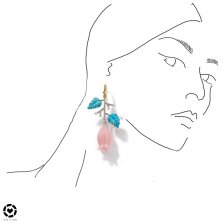Made in the sun: the amber fields of Ukraine
According to the ancient Greeks, Phaeton – the son of Helios, god of the sun – used his father’s golden chariot to ride across the sky. Fearing that the earth would be set on fire and destroyed, Zeus struck the chariot with a thunderbolt. Phaeton was thrown into the river and drowned. His grieving sisters became poplar trees, and their tears turned into amber, known in Greek as elektron, or made in the sun.
When you wear a piece of amber, you link yourself to the time of the dinosaurs. This fossilized tree resin, warm and soft to the touch, dates back millions of years, with inclusions such as insects, leaves, flowers, even dinosaur feathers that give us a window onto prehistoric ecosystems.
European amber has a rich honey color. It comes from a forest of giant conifer trees that once stretched for thousands of miles. The world’s largest known deposit is found along a coastal strip by the Baltic Sea, northwest of Kaliningrad, where it has been excavated since the mid-nineteenth century. Then, in the 1990s, Ukraine started to mine its own Rovno amber, called after the Rovno, or RIvne, district in northwest Ukraine, it what is now known by locals as the National Republic of Amber.
In China in ancient times, it was believed that tigers could live for 1000 years. After they die, their souls turn into amber – hu po in Chinese, meaning ‘tiger spirit’ – which was thought to bring good luck and have healing powers, and was used in jewelry, ornaments and medicine. In recent times, as supplies of jade became exhausted, a Chinese craze for hu po led to the price of amber soaring from $900 per kilo in 2011 to $2000 per kilo in 2015, and up to $4500 per kilo for very large stones.
Amber excavation in Ukraine became incredibly lucrative and, after the ‘EuroMaidan’ Revolution of 2014, as the country descended into lawlessness, criminal gangs operating in co-operation with corrupt police officers, Ukraine’s security service and politicians took charge of the country’s burgeoning amber trade. Amber miners – mostly villagers from areas with high unemployment – some equipped with pumps made from car or van parts, others with simple shovels, descend on forest areas where amber deposits have been found. Miners blast craters in the sandy soil and flood them with high-pressure water, so that amber will float to the surface. Then they wade into the water and use nets to fish out the stones.
Excavating as much as 400 tonnes of amber a year, the process has already turned many thousands of hectares of land into desert. No longer able to support plant life, once lush pine and birch forests and marshes now resemble a moonscape. Rivers and streams are polluted. It’s an ecological disaster.
Illegal miners have been making up to $50,000 a day, while the average salary for a Ukrainian factory worker is just $2,100 a year. Local youngsters now refuse to work in other jobs. There are drunken brawls and frequent fights over money: life in and around the amber fields resembles the wild west of America at the height of the gold rush. With no other means to support their families, the miners have been known to face down armed police trying to stop their activities. They bring guns, knives, even grenades to the pits. The amber is sold either to illegal Chinese wholesalers, or smuggled into Poland where it can be passed off as legally excavated Baltic amber and sold at the Gdansk stock market
With so much money to be made from bribes, no one involved in the protection rackets wanted to see Ukraine’s amber trade legalized, but at the end of last year, a bill was passed to try to control amber production.
Meanwhile, the oversupply of Rovno amber has drastically reduced its value, which has dropped to just $450 per kilo. And Chinese customers have become more discerning, now preferring smaller pendants to large ones, wanting only top quality beads of a certain size, color and shape. But our love story with amber is only on pause as it is still gaining popularity in Muslim countries such as Saudi Arabia, United Arab Emirates and Iran where it is used for prayer beads.
The wisdom of the ancient Greeks echoes through the millennia: as we tear up our forests to raid their resources, we risk setting our world on fire and destroying the precious ecosystems that support human life. The amber tears of Phaeton’s sisters are a warning: enjoy our planet’s magnificent treasures, but guard against human greed so that our children and grandchildren might share them too.
Portrait by Chris Gambrell.




